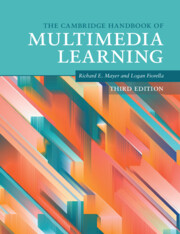Book contents
- The Cambridge Handbook of Multimedia Learning
- The Cambridge Handbook of Multimedia Learning
- Copyright page
- Contents
- Figures
- Tables
- Contributors
- Preface
- Acknowledgments
- Part I Background
- Part II Theoretical Foundations
- 5 Cognitive Theory of Multimedia Learning
- 6 Implications of Cognitive Load Theory for Multimedia Learning
- 7 Integrated Model of Text and Picture Comprehension
- 8 Implications of the Four Component Instructional Design Model for Multimedia Learning
- 9 Motivation and Affect in Multimedia Learning
- 10 Metacognition in Multimedia Learning
- Part III Basic Principles of Multimedia Learning
- Part IV Principles for Reducing Extraneous Processing in Multimedia Learning
- Part V Principles for Managing Essential Processing in Multimedia Learning
- Part VI Principles Based on Social and Affective Features of Multimedia Learning
- Part VII Principles Based on Generative Activity in Multimedia Learning
- Part VIII Multimedia Learning with Media
- Author Index
- Subject Index
- References
5 - Cognitive Theory of Multimedia Learning
from Part II - Theoretical Foundations
Published online by Cambridge University Press: 19 November 2021
- The Cambridge Handbook of Multimedia Learning
- The Cambridge Handbook of Multimedia Learning
- Copyright page
- Contents
- Figures
- Tables
- Contributors
- Preface
- Acknowledgments
- Part I Background
- Part II Theoretical Foundations
- 5 Cognitive Theory of Multimedia Learning
- 6 Implications of Cognitive Load Theory for Multimedia Learning
- 7 Integrated Model of Text and Picture Comprehension
- 8 Implications of the Four Component Instructional Design Model for Multimedia Learning
- 9 Motivation and Affect in Multimedia Learning
- 10 Metacognition in Multimedia Learning
- Part III Basic Principles of Multimedia Learning
- Part IV Principles for Reducing Extraneous Processing in Multimedia Learning
- Part V Principles for Managing Essential Processing in Multimedia Learning
- Part VI Principles Based on Social and Affective Features of Multimedia Learning
- Part VII Principles Based on Generative Activity in Multimedia Learning
- Part VIII Multimedia Learning with Media
- Author Index
- Subject Index
- References
Summary
A fundamental hypothesis underlying research on multimedia learning is that multimedia instructional messages that are designed in light of how the human mind works are more likely to lead to meaningful learning than those that are not. The cognitive theory of multimedia learning is based on three cognitive science principles of learning: the human information processing system includes dual channels for visual/pictorial and auditory/verbal processing (i.e., dual channels assumption), each channel has limited capacity for processing (i.e., limited capacity assumption), and active learning entails carrying out a coordinated set of cognitive processes during learning (i.e., active processing assumption).
Keywords
- Type
- Chapter
- Information
- The Cambridge Handbook of Multimedia Learning , pp. 57 - 72Publisher: Cambridge University PressPrint publication year: 2021
References
- 26
- Cited by

